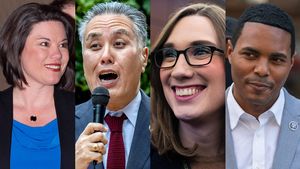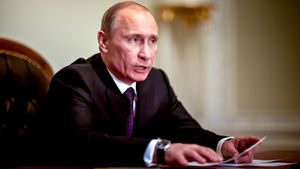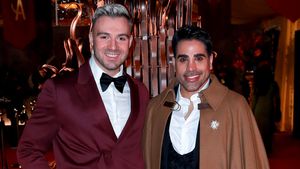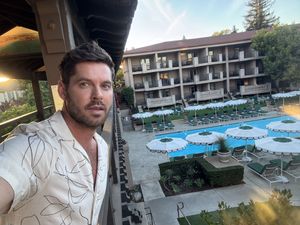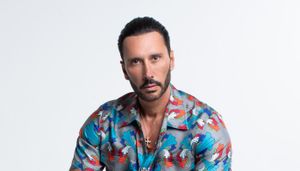Talk about when, in 1981, you first heard about the
cases of Kaposi's sarcoma and pneumocystis pneumonia
that indicated the beginning of the AIDS epidemic.
When the first
cases of pneumocystis pneumonia were reported to CDC, I
was asked to chair a task force. And one of the first tasks
was to go to New York City and visit a doctor and his
patient, who had Kaposi's sarcoma. The patient, as it
turned out, was within a year or two of my
age--a young man from a suburb of Detroit who went to
Catholic prep school, as I did. We laughed about our
childhood; we laughed about our high school
experiences, our similarities in backgrounds. What turned
out, as I got to know him more and saw him during several
more visits to New York City and watched his disease
progress and [watched] him die, was that the virus was
the real thing that separated us. He died in 12
months.
In the beginning of the epidemic, what did you
foresee for this mysterious collection of diseases?
We knew that
there were more people infected than were seriously ill. And
we were constantly touting how cases were doubling and this
was only the tip of the iceberg. But even we greatly
underestimated the extent of the problem.
In the early 1980s, you struggled to begin the
fight against AIDS with a paucity of funds. What are
your recollections about the politics of that era
and how they kept such a tight rein on public
health spending?
When the Reagan
administration took office in 1981, there was a
ramping-up of the defense budget and cutbacks in the
domestic budget. And those cutbacks affected the CDC
and the National Institutes of Health. We were
fortunate to have a flexible work force in terms of epidemic
intelligence service officers, and physicians, and some
science staff, but were severely constrained in the
areas of ancillary staff, and travel, and, in
particular, our ability to provide assistance in health
departments and universities to help with this. We were
constantly asking for more money.
What were some of your greatest needs that went unmet?
There was a
concern about having enough staff at the CDC. There were
inadequate numbers of support staff, particularly
statisticians. The CDC had a hiring freeze and some
reduction of force; that tends to make it more
difficult to get scarce resources donated or directed toward
a problem.
You were accustomed to researching gay men and
their sexual behavior because of your work with
hepatitis B in the 1970s. Most others at the CDC
were probably not ones to give much thought to gay
sex acts. Did you have trouble persuading people to join
the fight against AIDS?
One of the things
the CDC is known for is rapid responses to epidemic
challenges. And there was a lot of enthusiasm in a lot of
the young people in getting involved with this. The
problem we had was in identifying and developing
laboratory expertise and identifying support staff.
The [lack of] laboratory expertise was due in part to the
scarcity [of virologists] and perhaps the fear of
dealing with the unknown. I think it was
self-selection...They didn't sign on.
You advised San Francisco officials during the
effort to close down the city's bathhouses in the 1980s.
Today, much of the unrestrained sexual behavior
that once took place in such venues is now
facilitated by the Internet. How do public health
workers target the unsafe sex that goes on between
men who meet online?
Now, the problem
is mostly related to the fact that AIDS doesn't have the
amount of publicity or urgency for young people today as it
did then. And of course there are universal interests
in sex. We certainly can't shut down the Internet. So
I think the issue is more one of getting the community
concerned enough in order to have enough information out
there.
You have said that HIV prevention works "if its
hands aren't tied." How are the hands of U.S. prevention
efforts currently tied?
Where it's
easiest to see is in the area of drug abuse. Our country has
a true disdain for drug abusers. Our major tactic to
deal with drug abuse often is to imprison people.
We've not yet provided strong support for needle and
syringe exchange programs and, more importantly, for drug
treatment programs for people at risk for HIV. And we know
these things work.
What are you currently researching about HIV/AIDS?
At Emory, we have
a center for AIDS research that develops and tests HIV
therapies and vaccines.
Harper's magazine recently published an article by AIDS
dissident writer Celia Farber that espoused a
myriad of controversial views that HIV/AIDS is
hoax. How did you react to the story's publication?
I was really
disturbed that the magazine published such and article. It
was just so filled with inaccuracies and hopeless
speculation. It was really embarrassing for
Harper's that such an article should come out.
How do these skeptical theories still thrive
despite seemingly overwhelming evidence to the contrary?
It isn't
surprising to me that a small segment of people can be in
great denial and be skeptical about science in
general. But what's surprising to me is that they
should get so much press. There are people who think
the world is flat.
There is a pervasive anti-science, anti-condom,
anti-harm reduction attitude in the Bush administration
and among influential political conservatives. How
can public health experts counter attitudes that
are antithetical to effective HIV prevention?
I think it's
important for scientists and for public health officials to
speak up for what works and what doesn't.
What will AIDS look like in another 25 years?
I hope we'll have
an effective and safe vaccine. I hope we'll have
curative therapies. Those things are both really needed. If
we don't have those, we'll be dependent upon continued
public education, information and prevention
strategies. And I hope we're not still debating abstinence
vs. condoms, and needle and syringe exchange, or things like
that. And I hope we have much more open discussions in
community-based prevention efforts with strong
leadership around the world. The first 70 million
infections will far more than double in the next 25
years--to 150 million or more--unless we
can be much more effective with prevention.























































